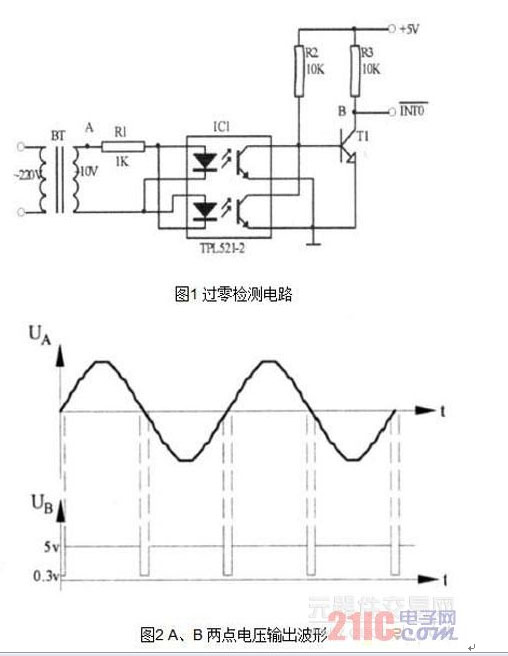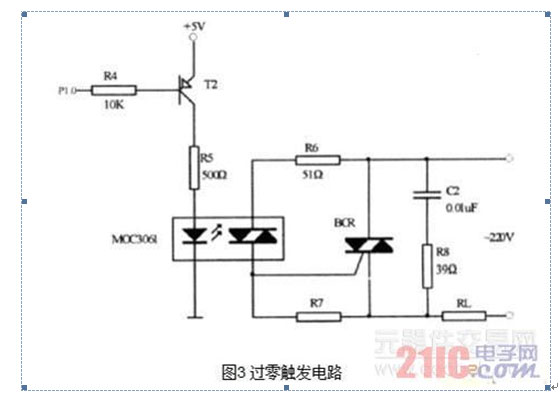Triac is a power semiconductor device, also known as triac. In the single-chip control system, it can be used as a power drive device. Because triac has no reverse withstand voltage problem and the control circuit is simple, it is especially suitable for AC Contact switch is used. The triac is generally connected to some high-power electrical appliances, and is connected to a strong power network. The anti-interference problem of its trigger circuit is very important. Usually, the trigger in the single-chip control system is triggered by a photocoupler. The signal is loaded to the gate of the thyristor. In order to reduce the interference generated when the driving power and the thyristor are triggered, the triggering of the bidirectional thyristor in the AC circuit often adopts a zero-crossing trigger circuit. Zero-crossing triggering refers to switching on at or near zero voltage. Because the zero-crossing trigger is adopted, the above circuit also needs a sinusoidal alternating current zero-crossing detection circuit.
1 Zero-crossing detection circuit
The circuit design is shown in Figure 1. In order to improve the efficiency and synchronize the trigger pulse with the AC voltage, it is required to output a trigger pulse every half of the cycle of the AC power, and the trigger pulse voltage should be greater than 4V and the pulse width should be greater than 20us. BT in the figure It is a transformer, and TPL521-2 is an optocoupler for isolation. When the sinusoidal AC voltage is close to zero, the two light-emitting diodes of the optocoupler are turned off, and the bias resistor potential of the base of the triode T1 turns it on to generate a negative pulse signal. The output terminal of T1 is connected to the external interrupt 0 of the microcontroller 80C51. input pin to cause an interrupt. In the interrupt service subroutine, the timer is used to accumulate the phase shift time, and then the synchronous trigger signal of the triac is issued. Figure 2 shows the output waveforms of the voltages at points A and B of the zero-crossing detection circuit.
2 Zero-crossing trigger circuit
The circuit is shown in Figure 3. In the figure, MOC3061 is a photocoupler triac driver, which is also a kind of photocoupler. It is used to drive the bidirectional thyristor BCR and play the role of isolation. R6 is the trigger current limiting resistor. R7 is the BCR gate resistor to prevent false triggering and improve anti-interference ability. When the P1. 0 pin of the microcontroller 80C51 outputs a negative pulse signal, T2 is turned on, the MOC3061 is turned on, triggers the BCR to turn on, and turns on the AC load. In addition, if the triac is connected to the inductive AC load, since the power supply voltage leads the load current by a phase angle, when the load current is zero, the power supply voltage is the reverse voltage, and the self-inductive electromotive force el of the inductive load is added to make Triacs are subjected to voltage values far exceeding the supply voltage. Although the triac conducts reversely, it is easy to break down, so the triac must be able to withstand this reverse voltage. Generally, a RC resistance-capacitance absorption circuit is connected in parallel between the two poles of the triac to realize the over-voltage protection of the bidirectional thyristor. C2 and R8 in Figure 3 are RC resistance-capacitance absorption circuits.
3 Conclusion
The triac zero-crossing trigger circuit is mainly used in the AC load control circuit of the single-chip control system. It can control high-power AC equipment such as electric furnaces and AC motors. It has been proven safe and reliable in practice. This paper focuses on the zero-crossing detection, trigger circuit. As for the software design is relatively simple, when the zero-crossing detection circuit detects a zero-crossing, an interrupt request is generated, as long as a trigger pulse is sent through the P1. , and will not be repeated here.

